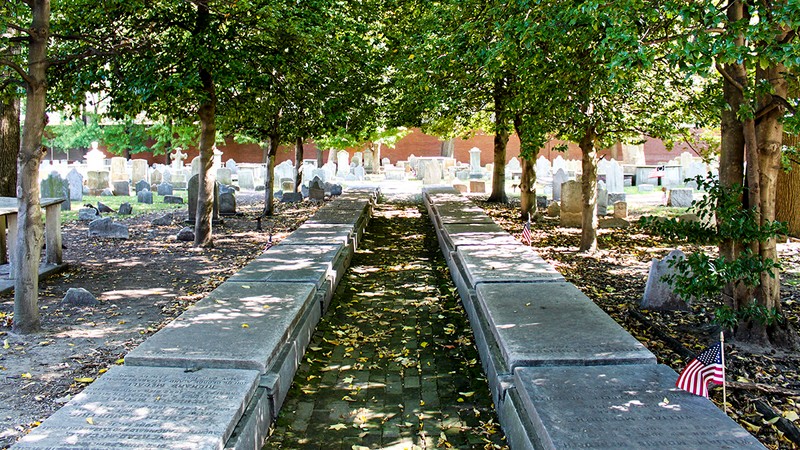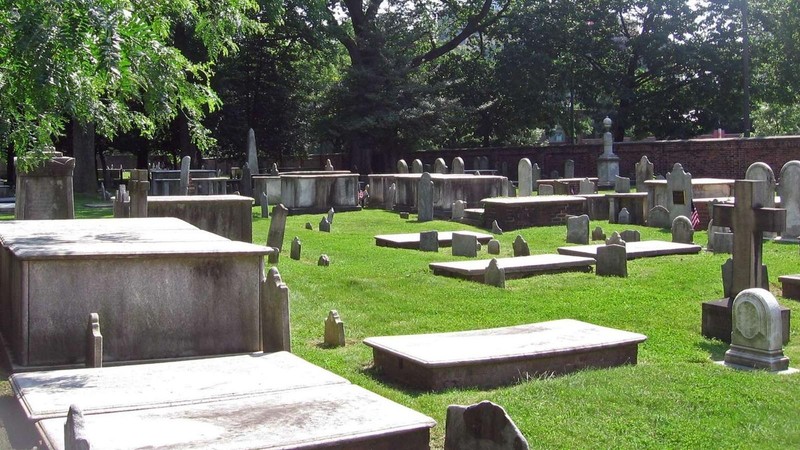Christ Church Burial Ground
Introduction
Text-to-speech Audio
Christ Church Burial Ground belongs to Christ Church (circa 1695) and is the final resting place of several signers of the Declaration of Independence, including Benjamin Franklin, Benjamin Rush, Francis Hopkinson, Joseph Hewes, and George Ross. Christ Church, an Episcopal Church, served as a place of worship for numerous Revolutionary War participants, including George Washington, John Adams, and Benjamin Rush. The Church began using the Burial Ground in 1719, and it remains an active cemetery today.
Images
Christ Church Burial Ground

Franklin aficionados sometimes toss pennies on his tombstone -- a practice that has contributed to the deterioration of the marker.

Christ Church Burial Grounds. This is the final resting place for Benjamin Franklin and other prominent leaders.

Backstory and Context
Text-to-speech Audio
Ben Franklin, who is buried alongside members of his family, is the most celebrated of those laid to rest in the cemetery; his gravesite can be seen from the sidewalk when the Burial Ground is closed. (While it was once stated that the Franklin family requested that his resting site always remains in view, it has been shown to be a move by the Burial Ground and city to help generate interest in the site.) When Franklin, a signer of the Declaration of Independence and the Constitution, as well as a successful diplomat, inventor, scientist, printer, and author, died, several thousand Philadelphians (some estimate as many as 20,000 people) followed his procession to the Christ Church Burial Ground. Over the years, leaving pennies on Franklin's grave has become a Philadelphia tradition.
Other notable people buried in the historic cemetery include:
- Commodore William Bainbridge (1774-1833): He fought the English, the French, and the Barbary pirates. The Barbary pirates of Tripoli took him, prisoner while he commanded the Philadelphia. Bainbridge remained a prisoner for nineteenth months until ransomed by President Thomas Jefferson.
- Commodore James Biddle (1783-1848): Along with his commanding officer, Commodore Bainbridge, Biddle was imprisoned for nineteen months by the Barbary pirates. After his release, Biddle took possession of the Oregon territory for the U.S. and negotiated the first U.S. treaty with China in 1846.
- Matthew Clarkson (died 1800): In addition to serving as Mayor of Philadelphia, he proved instrumental in caring for the sick during the 1793 yellow fever epidemic that killed ten percent of the city's population. During the outbreak, Clarkson worked with Absalom Jones and Richard Allen, two prominent members of Philadelphia's African-American community.
- Edwin Jesse DeHaven (1816-1865): A naval explorer and Arctic adventurer who once had his ship trapped in ice for nine months (he and his crew survived).
- John Dunlap (1742-1812): In addition to founding the Pennsylvania Packet, the first daily newspaper in America, he printed the Declaration of Independence and the U.S. Constitution.
- Joseph Hewes (1730-1799): Signer of the Declaration of Independence from North Carolina.
- Michael Hillegas (1729-1804): The first U.S. Treasurer.
- Francis Hopkinson (1737-1791): A signer of the Declaration of Independence from New Jersey. He was the first graduate of the University of Pennsylvania and a successful composer, playwright, poet, and lawyer. He was also an organist for Christ Church. (Some historians also believe he designed the flag that Betsy Ross is traditionally credited with sewing.)
- Major William Jackson (1759-1828): Signed the Constitution as Secretary to the Constitutional Convention. During the Revolution, he was taken prisoner while serving in South Carolina.
- Dr. John Kearsley (died 1772): He supervised the construction of Christ Church. He also trained Dr. James Derharn, acknowledged as the first African-American physician.
- Dr. Philip Syng Physick (1768-1837): Known as the "Father of American Surgery," Physick operated on Chief Justice John Marshall in 1834. He also invented numerous instruments used in surgical procedures.
- George Ross (1730-1779): Signer of the Declaration of Independence and known to be a friend of Native Americans.
- Dr. Benjamin Rush (1745? -1813): Signer of the Declaration of Independence. Rush is known as both "The Father of American Medicine" and "The Father of American Psychiatry." He is credited with demonstrating that mental illness could be treated with kindness, and he inoculated Patrick Henry against smallpox. Moreover, he supported the abolition of slavery prior to the American Revolution.
- Many more scientists, war heroes, U.S. congressmen, tradespeople, significant Philadelphians, and advocates of social change.
- Two more signers of the Declaration of Independence, James Wilson and Robert Morris, are buried at Christ Church just a few blocks away.
In short, the Burial Ground provides a window into early American history, from prominent people attached to the Revolutionary War to early doctors and much more. The Burial Ground underwent significant renovations at the end of the twentieth century; it opened in 2003 after being closed for twenty-five years.
Sources
Ben Franklin Historical Society. Accessed January 7, 2022. "http://www.benjamin-franklin-history.org/."
Dixon, Mark. "How Franklin’s Grave Became A Monument And Philadelphians Were Persuaded To Like It." Hidden City. April 19, 2017. https://hiddencityphila.org/2017/04/behind-the-publicity-stunt-at-benjamin-franklins-grave/.
"The History and People of Christ Church." Christ Church (of Philadelphia). Accessed January 7, 2022. https://christchurchphila.org/history/.
"About the Burial Grounds." Christ Church (of Philadelphia). Accessed January 7, 2022.https://christchurchphila.org/about-the-burial-grounds/.
"Christ Church Burial Ground." The Cultural Landscape Foundation. Accessed January 7, 2022. https://www.tclf.org/landscapes/christ-church-burial-ground.
Photo by Zachary Lifton, 2012. https://www.tclf.org/landscapes/christ-church-burial-ground
https://christchurchphila.org/about-the-burial-grounds/
https://www.nps.gov/places/000/christ-church-burial-ground.htm
